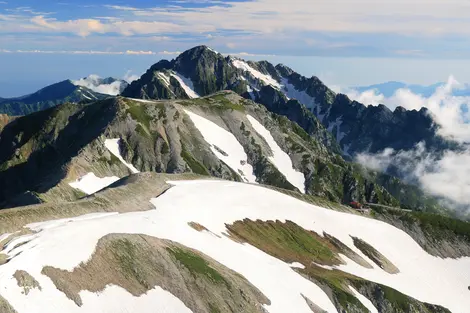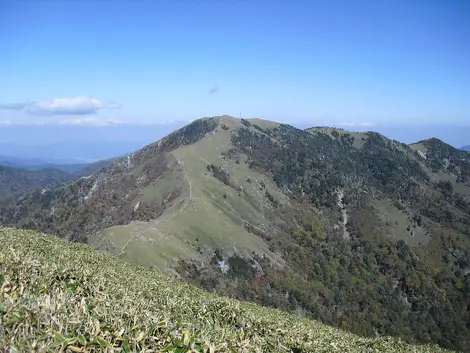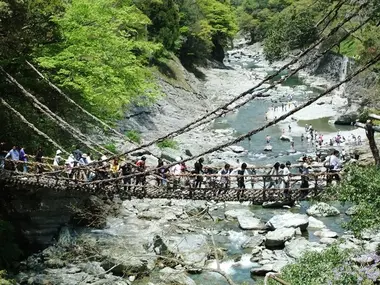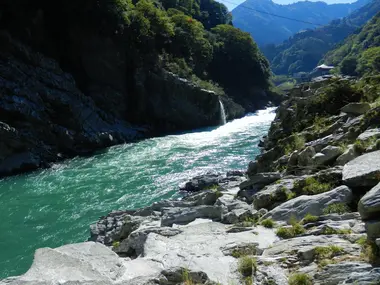Mount Tsurugi Quasi-National Park 剣山国定公園
- Published on : 06/06/2019
- by : O.F.
- Youtube
Hiking in Shikoku Island
The Tsurugisan Kokutei Koen is one of the highlights of the island of Shikoku. Stretching to the border of the prefectures of Tokushima and Kochi, the Tsurugisan quasi-national park covers an area of nearly 210 km2. Several natural treasures are included: Mount Tsurugi of course, but also part of the Yoshino River and the Iya Valley, with the Oboke and Koboke gorges.
Mount Tsurugi
Also called Tsurugi-san, this 1955 meter high mountain is a popular destination for hikers. Indeed, even if it is the second-highest mountain on the island of Shikoku, it is a climb accessible to everyone, even beginners.
To start your adventure, you can take a chairlift that takes you to a station near the top. From there it takes about 30 minutes to walk the most direct route up the mountain. There is also an alternative route via Otsurugi Shrine, which will only take you a few minutes longer.
Mount Tsurugi is on the list of " Japan's 100 Famous Mountains ", created by writer and mountaineer Kyuya Fukuda.
Access: We recommend renting a car to reach Mount Tsurugi. It is also possible to get there by bus from the city of Kudo but beware, these buses only run on weekends and from April to November.
The Iya Valley (Iyakei)
It is the most important natural treasure of Tsurugisan Quasi-National Park. Located between the cities of Kochi and Marugame, this remote mountainous valley in western Tokushima Prefecture is characterized by steep slopes and deep rocky gorges.
The Iya Valley is known for its so-called Kazurabashi bridges, suspension bridges made of vines, and steel crossing. The region is also known for its natural hot springs and you will therefore find many Onsen there!Part of the Yoshino River is thus included in the quasi-national park of Tsurugisan. This is where you will find the rapids of the Shikoku Gorge in which it is possible to go rafting.
Oboke and Koboke gorges
These are the names given to the two banks of the Yoshino River Gorge. These narrow and steep gorges are located near the entrance to the Iya Valley.
They are particularly recognizable by their turquoise-colored water and the rock walls that surround them, forged by the movements of tectonic plates millions of years ago.
Their beauty earned them designation as a National Natural Treasure in 2014.
Access: The Iya Valley and its gorges are accessible by Okobe Station by train from Okayama City and Awa-Ikeda Station from Miyoshi City.
The area is ideal for travelers and especially hikers who want to get away from the hustle and bustle of many Japanese cities. This quiet mountainous valley in the center of Shikoku, in addition to being well known for its spectacular landscapes, is an area that has retained all of its charm and authenticity.
The valley also has a rich history. Indeed, the valley served as a refuge for members of the Taira clan (also known as the Heike) who fled there after losing the Gempei War (1180-1185) in the late Heian period ( 794-1185).

Oboke Gorge
linkyuan lee
What is a quasi-national nature park in Japan?
Similar to national parks, the distinction of "quasi-national park", or Kokutei kōen in Japanese, is given by the Japanese Minister of the Environment to protect natural areas with a heritage of regional importance.
Today there are 56 quasi-national parks in Japan. The latter represents approximately 5.2% of the area of the country.
- Discover another quasi-national park: Akiyoshidai Quasi-National Park
Address, timetable & access
Address
Phone
+81 883-53-2043Timetable
We recommend renting a car in order to reach Mount Tsurugi. It is also possible to get there by bus from the city of Kudo but beware, these buses only run on weekends and from April to November.



























